1/1/2021
The Current State of Substrates in 2021
Dr. Brian E. Jackson
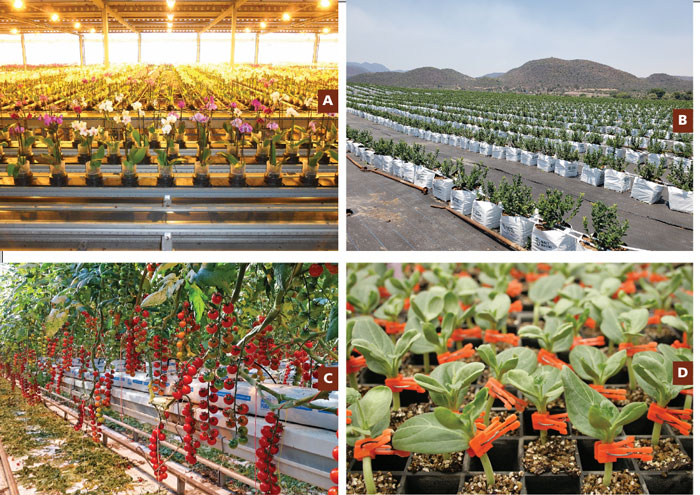
The value, demand and dependency for soilless substrates (growing media) has never been greater. NEVER. Last year brought unprecedented challenges as well as many opportunities to the horticulture industry worldwide. These challenges and opportunities set the stage for what should be a very interesting 2021 for all sectors of the industry. Factors affecting the current and future status of soilless substrates include the COVID-19 pandemic, political trade wars, extreme weather patterns and climate change, existing and proposed environmental regulations, and product and consumer trends.
Figure 1. Soilless substrates are increasingly being used in the production of: A) floriculture and foliage plants; B) soft fruit crops; C) vegetables; and D) young plant production in various types of indoor and outdoor growing systems.
State of the industry
Where to start? Hmmm … how about with the pandemic? COVID has had two very direct impacts on the global substrates industry. First, the increased sales from the hobby market as people discovered or re-discovered gardening during quarantine, yielded one of the most profitable spring and summer seasons on record. This demand for plants and garden products created supply issues in sectors of the substrate industry.
Secondly, the shutdown and restricted operations of various industries around the globe halted or severely disrupted raw material acquisition, processing, handing and shipments. COVID has also interrupted transportation routes and caused personnel shortages (including migrant workers), among other issues.
The current projected volume of substrates consumed globally in 2019 is estimated to be 65 to 70 million cubic meters (m3). These estimates are difficult to accurately project due to the lack of requirements or standardization for reporting volumes and total sales of substrate materials by the manufacturers.
Recent projections for global substrate demand have shed light on the challenges the industry faces in the years and decades ahead. A recent study lead by Chris Blok from Wageningen University projects the demand for substrates in 2050 to reach about 280 million m3, a 420% increase in just the next 30 years. New crops being produced in substrates (including soft fruit, vegetables and leafy greens, transplants, and cannabis) are helping to drive the future demand (Figure 1) in addition to the emerging Chinese horticulture market.
Actions by the industry
Substrate manufacturers are aware of their role in many new and emerging issues that face growers and the horticulture industry as a whole. Initiatives are already being implemented on environmental preservation and stewardship, sustainability, life cycle analysis, and cradle-to-grave/cradle assessments, substrate hygiene and safety measures, and societal and socio-economic impacts and assessments, among others.
As part of a science-based approach to address problems and opportunities in the substrate industry, many manufacturers are employing new (some voluntary and some mandated) quality-control measures and certifications to ensure sustainability efforts and environmental impact guidelines. Among the certifications and organizations that substrate companies participate in include the Organic Materials Review Institute (OMRI), The European Responsibly Produced Peat (RPP) certification program and the Veriflora Scientific Certification System (SCS) Responsibly Managed Peatlands Certification.
In response to the increased use of soilless substrates for the production of consumable crops, there are new safety measures and quality-control parameters in place to address the heightened concern and demand of substrate customers and product consumers. Monitoring for heavy metals and harmful pathogens is now a matter of routine for substrate companies as efforts to ensure their products maintain rigid standards for use in the production of consumable crops in soilless culture. Companies across North America and Europe have also increased security and monitoring of raw material supply chains, as well as implemented additional security measures to further reduce the risk of substrate contamination.
News from the industry
Numerous societies and professional organizations that govern and guide the substrate industry have published statements and policies regarding the current state of the industry, as well as the challenges and opportunities that lie ahead in the near and distant future. According to the German Industrieverband Garten group (IVG), the growing media industry is fully aware of its social responsibility, and as such, is committed to reducing the portion of peat used in professional and retail/hobby substrate markets in the years ahead.
Similarly, the Dutch substrate manufacturers group VPN stated in a press release in November of 2020 that future global demand was sharply increasing and that the demand on raw materials would be greater than normal. They conveyed a strong argument of the continued use of Responsibly Produced Peat with a heavy reliance on innovation and more attention to renewable non-peat raw materials to support the ever-growing plant production industry. No such verbiage, at least to this extent, is coming from the Canadian peat organizations.
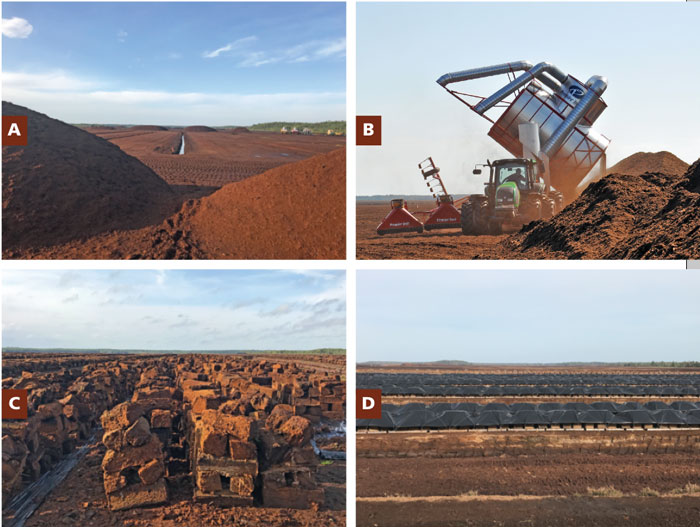
Peat
Peat remains the most important substrate material used in horticulture and its demand increases annually. Whether milled and vacuum harvested as is common in Canadian production (Figures 2A and 2B) or block (sod) cut, which is common in Europe (Figures 2C and 2D), peat is uniquely processed and formulated to create the highly consistent and reliable substrates that horticulture has relied on for many decades. Fortunately, Canadian peat moss was deemed “an essential good” during the early days of the COVID shutdown due to its role in food security, so peat harvesting and transport into the U.S. wasn’t stopped.
Figure 2. Canadian and European peat moss that’s either milled/vacuumed (A and B) or block cut (C and D) continues to be the backbone of soilless substrates. Photos: A, C and D—Brian Jackson; B—Klasmann-Deilmann.
The 2020 Canadian peat harvest is reported to be varied across the country. The harvest in the eastern parts of Canada exceeded or nearly met expected harvest yields, while harvest in the west were below expectations. The exact totals and extent of peat harvest (and product availability in 2021) isn’t yet very clear, but supplies should be strong. It’s important to note that Canadian peat producers are preparing for the future and continue to open up additional harvest sites across Canada (which has 281 million acres of peat bogs of which 0.03% have been harvested) after completing the extensive leasing and permitting processes within each Provincial jurisdiction.
In Europe, peat harvest for some companies was good, others OK, and yet others considerably under expected or projected harvest volumes. There are many countries that are facing peat harvest reductions, and in some cases, restrictions for the future. Some examples are the targeted end use of peat in England by 2030, and Scotland and Wales are likely to follow after. Germany, France, Belgium, the Netherlands and Finland all have current governmental discussions or regulations aimed at limiting peat extraction, denying new permits for harvesting or implementing peat-free measures all together. Ireland, a traditional peat powerhouse, stopped peat extraction completely in 2020. That said, current peat supplies and harvests in Europe are sufficient to meet the current demand (assuming good weather for harvests) in the near future.
What does the long-term future of peat production in Europe look like and where will more peat be sourced? Some say the answer lies to the East … in Russia. Some peat companies already have harvest sites established in Russia and others are likely to follow.
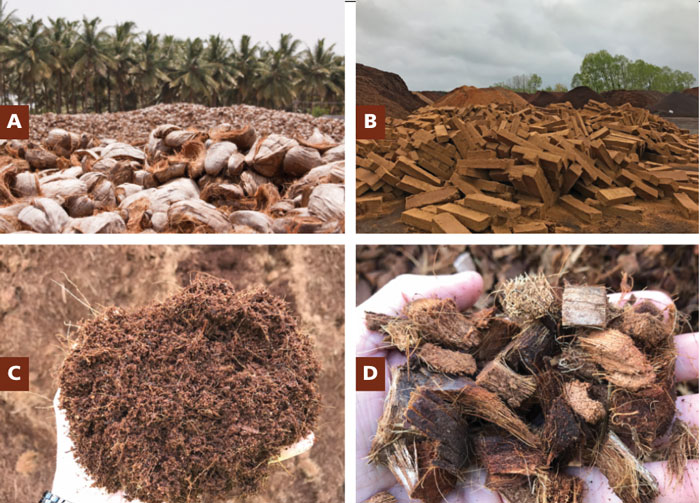
Coir
Coconut coir is the number one peat alternative on a global scale and the global demand increases every year. In the past 20 years, the production and processing of coir pith has increased from 1 to almost 10 million m3 in 2019. Despite the success, the demand is high and many suppliers already cannot supply enough product to meet the demand—and that was before COVID.
Figure 3. Coconut coir products originating primarily from India, Sri Lanka and Central America are the second-most abundantly used raw materials (components) in growing media.
Photos: A—Dutch Plantin; B, C and D—Brian Jackson.
In the early stages of the pandemic (March-April 2020), the industry in India and Sri Lanka (responsible for 90% of global production) forced processing mills to close during peak production season, only to reopen and be hampered by unusually prolonged rain events and shortages in sea freight containers—all of which greatly affected global coir supplies.
The coir industry has made many significant advances in the past decade, including more product offerings, more variation in particle sizes (Figure 3) and physical properties, improved chemical properties (EC and salts), and cleaner processing methods. The coir industry also has challenges to face in the future if the industry is to grow. Investments in infrastructure, skilled employment, stable political climates and proximity to sea ports all have large impacts on the availability of coir products and supplies in the future. Significant efforts are underway to solve these problems and allow coir use to expand across the globe. In the meantime, there could likely be shortages of some products in some areas.
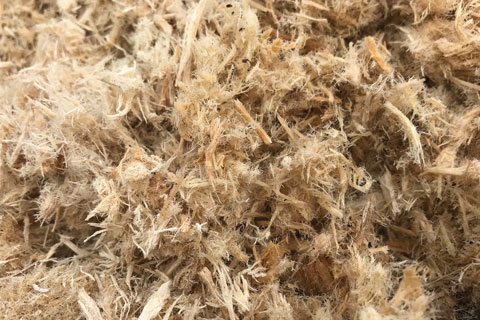
Wood
More has probably been written about wood materials than any other substrate component in the past few years (Figure 4). Here in North America, the use of wood products will increase significantly, as they’re abundant, economical and fairly well accepted by the industry. More R&D will help make wood even more available and accepted in the near future.
Figure 4. Wood components in growing media are increasing in usage around the globe and are predicted to be utilized even more in the coming decades. Photo: Brian Jackson.
Many European substrate manufacturers consider wood to be the most important peat alternative in Europe. That may not be the opinion of all, but it’s shared by many. Many of the largest European substrate companies are planning significant increases in wood usage over the next three to five years, with some companies planning to reduce all peat products by 30% (with wood) by 2023.
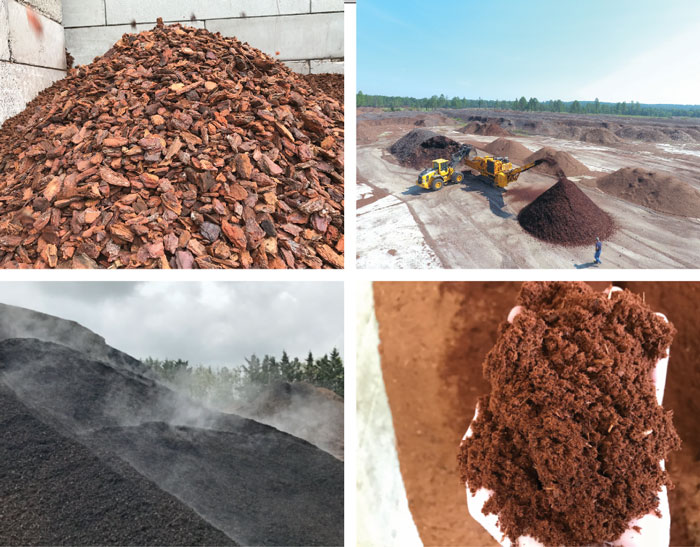
Bark
The use of bark products (aged or composted) continues to increase in the North American growing media markets (Figure 5). More bark is being added to greenhouse substrates, as well as retail/consumer products. Bark is still abundant and readily available across the Pacific Northwest and the Southeast U.S. The spiked demand of bark during the COVID pandemic hasn’t led to bark shortages, as the forestry/timber industry has continued high harvest production levels. However, what some bark producers have had (or chosen) to do is shorten their aging and processing time to meet the demands of customers. Bark in Europe, however, seems to be far less available in most areas going into 2021.
Figure 5. Bark products continue to have increased use in substrate formulations due to their availability, stability, structural properties and particle size variations. Photos: Brian Jackson.
Summary
Following the lead of the peat (and other) industries, there’s a need for non-peat alternatives that are entering or already established in the growing media market to provide scientific-based information on the environmental, social and economic impacts of the use of those materials in horticulture. To date, not much has been provided on some materials, yet many of these are being advocated as the future alternatives to peat.
Also, while inorganic substrate materials weren’t specifically referenced in this article—as well as numerous other organic substrate components—many of the same concepts, action items, and potential threats and opportunities are true for them as well. Notably, the changes that occur in the perlite and stone/rockwool industries across horticulture will be of interest in the coming year(s), as those products remain extremely valuable, but also face threats of new material competition and alternative growing practices.
While the state of the substrate industry is strong, it’s faced with unprecedented demand challenges going into the future. Growers and other substrate consumers should be proactive in making their orders this year and next. It’s likely that prices could increase on certain substrates in certain areas. Growing soillessly is the future of many horticultural crops, especially in areas of the world where arable land, water, labor and climate extremes are of a critical nature. The substrate industry will now, like in the past, rise to the occasion and work hard to supply growers and consumers with high quality products to meet the current and future demand. GT
Brian E. Jackson is an Associate Professor and Director of the Horticultural Substrates Laboratory at North Carolina State University. Brian can be reached at Brian_Jackson@ncsu.edu.